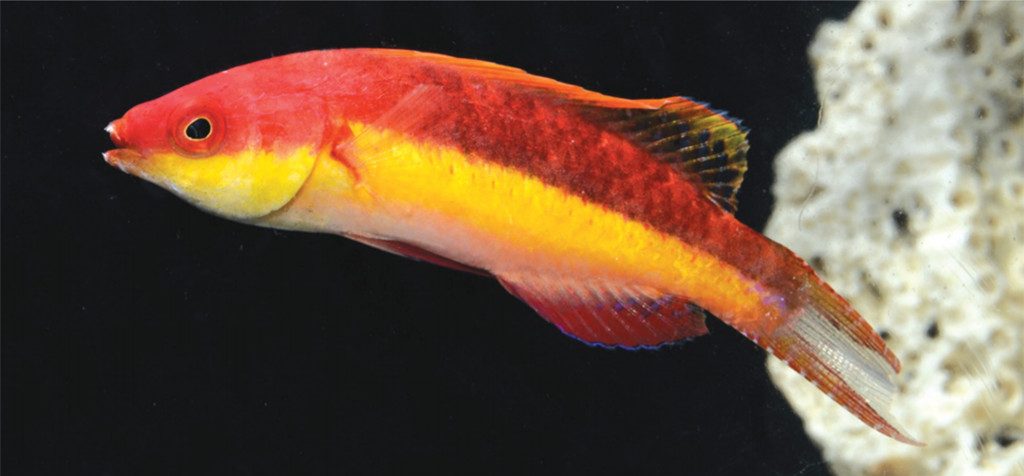
Cirrhilabrus greeni, freshly collected male holotype, 47.3 mm SL, eastern Timor Sea Credit: M.P. Hammer / Allen & Hammer 2017
The remote reefs off Northern Australia have yielded yet another new species of fairy wrasse with the description of Cirrhilabrus greeni. This exciting discovery comes courtesy of the collectors at Monsoon Aquatics, the same group that brought us the Monsoon Fairy Wrasse (C. hygroxerus) last year. Both fishes occupy the same habitats in the Timor Sea, a region 300km northwest of Darwin, Australia, in “sloping rubble bottoms” at depths of 18-40 meters. Obviously, collecting them takes a considerable amount of time and effort, so expect this fish to be among the rarer labrids available to aquarists.
Cirrhilabrus greeni is an especially interesting species for those interested in the origins of fairy wrasse biodiversity. It’s closest relatives include the Redfin Fairy Wrasse (C. rubripinnis) and the soon-to-be-named Bluethroat Fairy Wrasse (C. aff. tonozukai), from the Philippines and Indonesia, respectively. We can see evidence for their relatedness in the tall profile of the dorsal fin, the enlarged pelvic fins, and their overall color scheme of a red back and a lighter belly. Cirrhilabrus condei (Raja Ampat to Vanuatu) and the enigmatic C. walshi (American Samoa) also belong to this same lineage.
The Sunset Fairy Wrasse’s most unique trait has to be its unorthodox caudal fin pattern, which stands in stark contrast to what we find elsewhere in its species group. Sexual signaling is a prime driver in the speciation of this genus, and, for this particular lineage, the caudal fin is especially important, creating a beautiful reflective shimmer when held erect. But C. greeni bucks this trend—the central portion of its tail is instead transparent, contrasting with the red margins to create a faux-lunate appearance. Why has this one species abandoned such an important part of its reproductive behavior?

Cirrhilabrus greeni, aquarium photographs of live male holotype, 47.3 mm SL, eastern Timor Sea Credit: M.P. Hammer / Allen & Hammer 2017
It’s possible this may have to do with the coöccurence of this species with the closely related C. hygroxerus. That fish belongs to a sister lineage which diversified in the Indian Ocean, and the Timor Sea is one of the few places where these Indian and Pacific Ocean groups overlap. Since it appears that both of these fishes speciated in this region, perhaps they managed to do so by adopting distinct mating displays, with the Monsoon Fairy Wrasse maintaining the reflective caudal fin and the Sunset Fairy Wrasse doing away with it.
Interestingly, the available genetic data shows no obvious differences between this new species and two of its Pacific relatives, C. rubripinnis and C. aff. tonozukai. Clearly, these wrasses have been diversifying at an accelerated rate, with the emergence of their sexual color differences outpacing our ability to detect the genetic differences that underpin them.
Finally, the reefs of the Timor Sea are likely to have yet more secrets to reveal. No less the four additional species are suspected in the region, and we’ll probably see some of these named in the coming year. 2018 is shaping up to be an exciting time for this genus.
- Allen, G.R. & Hammer, M.P. (2017) Cirrhilabrus greeni, a new species of wrasse (Pisces: Labridae) from the Timor Sea, northern Australia. Journal of the Ocean Science Foundation, 29, 55–65. doi: http://dx.doi.org/10.5281/zenodo.1115674









0 Comments